Sorry about that - was just alerted to it. I’ve disabled the “other” option now. It was fine a few hours ago, looks like we have a sick troll here. :/
- 22 Posts
- 431 Comments

 8·6 months ago
8·6 months agoSerenity for sure. I love the 90s aesthetic and would like to see it make a comeback. At the very least I’d like to see their Ladybird browser become mainstream - we really need more alternatives to the Chromium family.

 4·6 months ago
4·6 months agoNice, glad that got sorted. :) BTW could you edit the title please and mark it as [SOLVED]? Thanks!
I’m not moving any goalposts. You’re the one arguing about the semantics around “Plasma”, and I keep saying that’s irrelevant.
Refer back to my original comment which was, and I quote:
So, are there any plans to reduce the bloat in KDE, maybe even make a lightweight version (like LXQt) that’s suitable for older PCs with limited resources?
To clarify, here I was:
- Referring to KDE + default apps that are part of a typical KDE installation
- Stating that a typical KDE installation is bloated compared to a typical lightweight DE like LXQt
- Saying with the intention that the “bloat” is RELATIVE, with respect to a older PC with limited resources
The ENTIRE point of my argument was the KDE isn’t really ideal RELATIVELY, for older PCs with limited resources, and I’m using LXQt here are a reference.
In a subsequent test, here’s a direct apples-to-apples(ish) component comparison:
Component Process_KDE RAM_KDE Process_LXQt RAM_LXQt WM kwin_x11 99 openbox 18 Terminal konsole 76 qterminal 75 File Manager Dolphin 135 pcmanfm-qt 80 File Archiver ark 122 Lxqt-archiver 73 Text Editor kwrite 121 featherpad 73 Image Viewer gwenview 129 lximage-qt 76 Document Viewer okular 128 qpdfview-qt6 51 Total 810 446 plasmashellwas sitting at 250MB btw in this instance btw.The numbers speak for themselves - no one in their right minds would consider KDE (or
plasmashell, since you want to be pedantic) to be “light”, in RELATION to an older PC with limited resources - which btw, was the premise of my entire argument. Of course KDE orplasmashellmight be considered “light” on a modern system, but not an old PC with 2GB RAM. Whether something is considered light or bloated is always relative, and in this instance, it’s obvious to anyone that KDE/plasmashellisn’t “light”.
I tested this myself on two identical VMs with 2GB RAM, one installed with Fedora 40 KDE, and another with Fedora 40 LXQt, both set to use X11 (because LXQt isn’t Wayland ready yet), both updated and running the latest kernel 6.8.10-300.fc40.
I logged into the DEs, opened only two terminal windows and nothing else, ran, and ran htop:
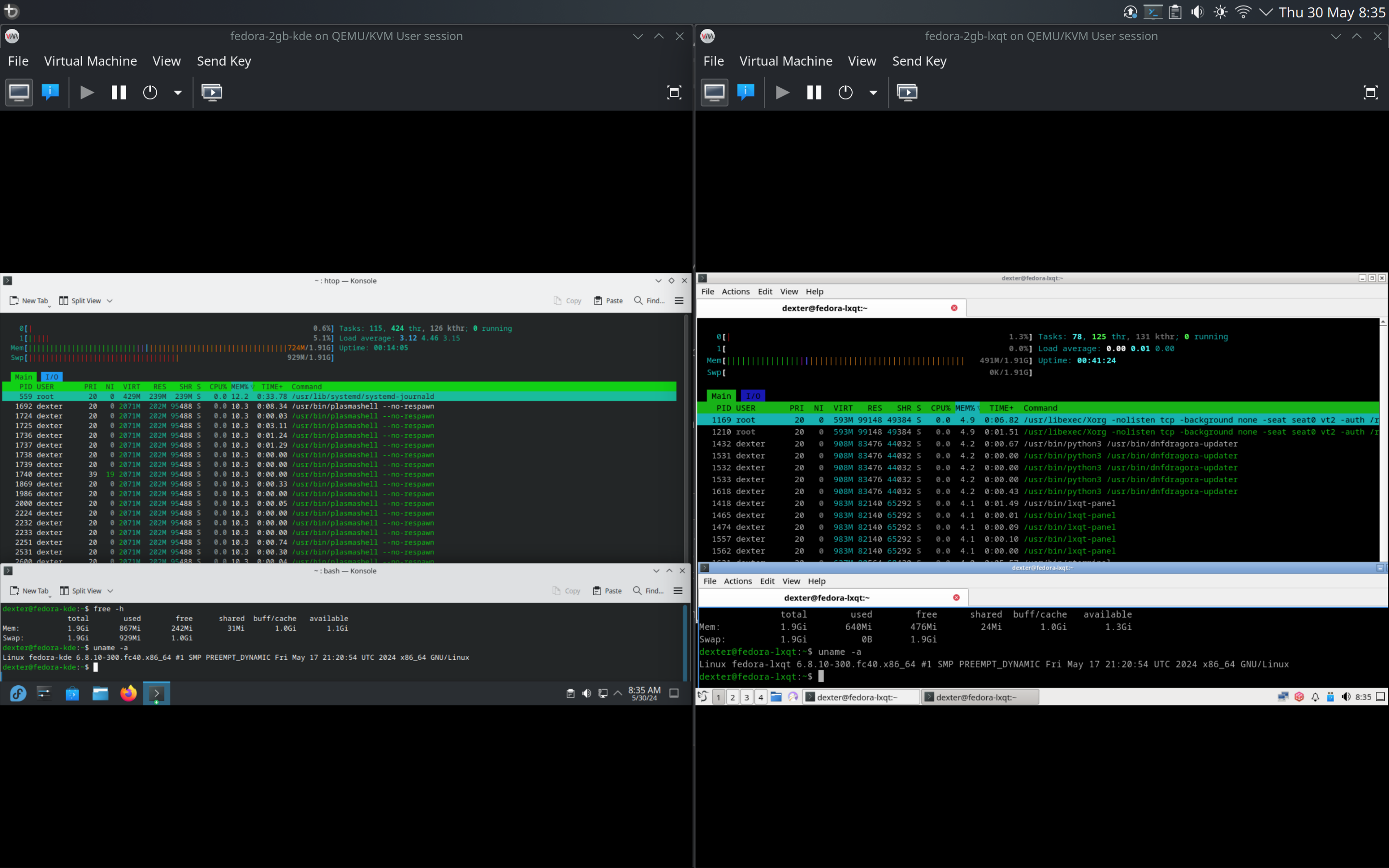
The KDE VM was unsable when I disabled swap - it completely froze on me. Meanwhile, LXQt chugged on just fine. Of
Of course, I could get rid of some bloat like akonadi, so I did that and rebooted my machine. Then I compared just the essential components, but I excluded plasmashell because it includes stuff like the panel and notifications, unlike LXQt where they’re all separate components so you can’t really compare them:
Component Process_KDE RAM_KDE Process_LXQt RAM_LXQt WM kwin_x11 99 openbox 18 Terminal konsole 76 qterminal 75 File Manager Dolphin 135 pcmanfm-qt 80 File Archiver ark 122 Lxqt-archiver 73 Text Editor kwrite 121 featherpad 73 Image Viewer gwenview 129 lximage-qt 76 Document Viewer okular 128 qpdfview-qt6 51 Total 810 446 plasmashell was sitting at 250MB btw in this instance btw.
You’re arguing semantics and that’s not the point I’m trying to argue here. Forget the term “Plasma”. I don’t really care about what the DE is branded as or what’s in “Plasma” the software package. When I say “KDE”, I mean the desktop + all the basic default/recommended apps that you’d see on a typical KDE installation, such as Dolphin, Konsole, Kate, Kalculator, Spectacle etc that’s part of the KDE project. IDK whether the apps I’ve mentioned are considered part of “Plasma” or not, but again, that’s not the point, I’m saying this is what I meant when I said “KDE” - and what most people would expect when they picture a “KDE” environment.
Anyways, I tested this myself on two identical VMs with 2GB RAM, one installed with Fedora 40 KDE, and another with Fedora 40 LXQt, both set to use X11 (because LXQt isn’t Wayland ready yet), both updated and running the latest kernel 6.8.10-300.fc40. I logged into the DEs, opened only two terminal windows and nothing else, ran, and ran
htop. The screenshot speaks for itself:
And when I tried disabling swap on both machines, the KDE machine was practically unusable, with only 53MB RAM remaining before it completely froze on me. Meanwhile, the LXQt one was still very much usable even without swap enabled.
I’d like to see you try running without swap and see how it fares. And if you think it’s unfair disabling swap on a 2GB machine - try installing LXQt yourself, disable swap and see for yourself how much more usable it is compared to KDE.
And this is why I say KDE is bloated and not suitable for old machines.
Edit: Also, check out the memory consumption listed by a user in this post: https://lemmy.nz/comment/9070317
Edit2: Here’s a screenshot of the top 30 processes on my test systems, side-by-side:
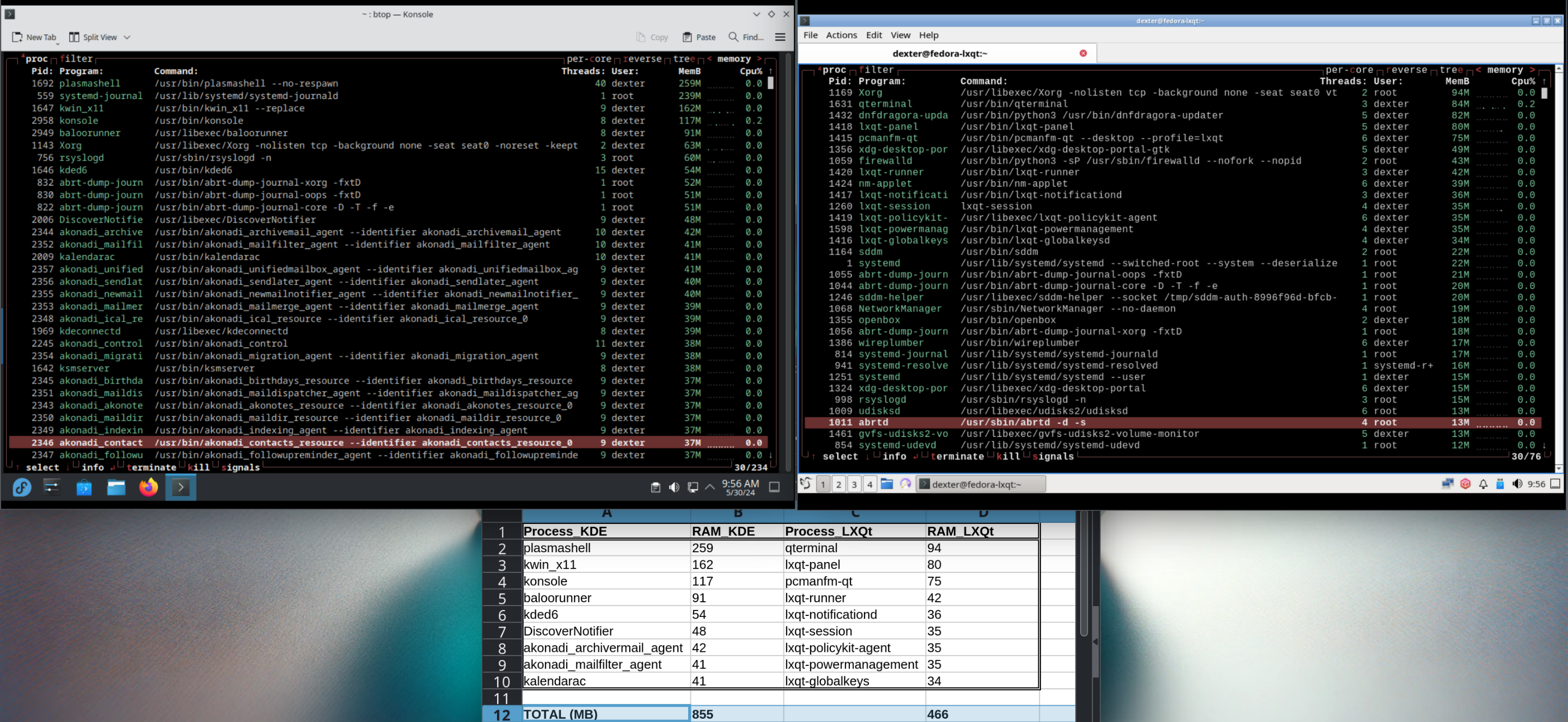
Of the above, I calculated the usage of the top 10 processes specific to each respective DE, and you can see that KDE’s memory usage is almost double that of LXQt. Had I counted all the DE-specific processes, it’d no doubt be a lot more than double.

 4·6 months ago
4·6 months agoDo you have
base-develinstalled? If not, install that and try again.
Correct me if I’m wrong, but this #OptGreen project isn’t talking specifically about Plasma, is it? They don’t mention Plasma anywhere on the page they linked.
In any case, that’s irrelevant, also, I don’t doubt that KDE can’t run at all under the specs you mentioned - that’s not the issue. The question is, how much free/usable RAM do you actually have on that machine - let’s say with no apps open first, and with then check again with Konsole + Dolphin + KWrite/Kate open? And for fun, fire up Konqueror as well and check again.
Edit: Screenshots proving that what you’re saying is not correct:


I’m not talking specifically about Plasma, I’m talking about the “DE” part of KDE in general; and particularly in this context of repurposing and extending the life of old PCs.
I find it a bit ironic for KDE to be pushing this message, when it’s a heavy DE (relatively speaking) - it’s NOT what anyone would have in mind when when selecting a DE for an old PC.
For instance, take LXQt - run the default/recommended file browser, terminal and text editor, and compare it with KDE + equivalents - you’d see a significant difference in resource consumption. On a system with low RAM, that extra bit of free memory makes a big difference, as it could mean avoiding the penalty hit of the swap file, which you’d invariably run into as soon as you fire up a modern Web browser. So it’s vital that the DE use as little resources as possible on such a machine.
So, are there any plans to reduce the bloat in KDE, maybe even make a lightweight version (like LXQt) that’s suitable for older PCs with limited resources?

 9·6 months ago
9·6 months agoYou should still have the previous package in your cache right? If so, extract that and the current package, and then compare the two folders to see what’s changed -
meldis a good tool for that.
The problem is that games don’t run at all or require major effort to run without issues.
A major cause for that is the distro - when it comes to gaming, the distro makes a huge difference as I outlined previously. The second major cause is the flavor of Wine you chose (Proton-GE is the best, not sure what you used). The third major cause is checking whether or not the games are even compatible in the first place (via ProtonDB, Reddit etc) - you should do this BEFORE you recommend Linux to a gamer.
In saying all that, I’ve no idea about pirated stuff though, you’re on your own on that one - Valve and the Wine developers obviously don’t test against pirated copies, and you won’t get much support from the community either.

 12·6 months ago
12·6 months agoThe following list of software packages is required for ntfs file system support: ntfs-3g / ntfsprogs.
First of all, make sure you install
ntfsprogs-ntfs3from the AUR (this package doesn’t install the old/buggyntfs-3gdriver).Once it’s installed, you can then then attempt to fix drive using
sudo ntfsfix /dev/nvme0n1p2 --clear-dirty.Run it a second time to verify, and that should do the trick. No need to boot into Windows.
Btw, in case you’re mounting this drive manually, make sure you specify
-t ntfs3, otherwise it’d use the old/buggyntfs-3gdriver - which we don’t want. In fact, I’d say get rid ofntfs-3gif you’ve got it - no point keeping it around if you’re on a recent kernel.

 1065·6 months ago
1065·6 months agoUnfortunately you chose the wrong distro for your friend - Linux Mint isn’t good for gaming - it uses an outdated kernel/drivers/other packages, which means you’ll be missing out on all the performance improvements (and fixes) found in more up-to-date distros. Gaming on Linux is a very fast moving target, the landscape is changing at a rapid pace thanks to the development efforts of Valve and the community. So for gaming, you’d generally want to be on the latest kernel+mesa+wine stack.
Also, as you’ve experienced, on Mint you’d have to manually install things like Waydroid and other gaming software, which can be a PITA for newbies.
So instead, I’d highly recommend a gaming-oriented distro such as Nobara or Bazzite. Personally, I’m a big fan of Bazzite - it has everything you’d need for gaming out-of-the-box, and you can even get a console/Steam Deck-like experience, if you install the
-deckvariant. Also, because it’s an immutable distro with atomic updates, it has a very low chance of breaking, and in the rare ocassion that an update has some issues - you can just select the previous image from the boot menu. So this would be pretty ideal for someone who’s new to Linux, likes to game, and just wants stuff to work.In saying that, getting games to run in Linux can be tricky sometimes, depending on the game. The general rule of thumb is: try running the game using Proton-GE, and if that fails, check Proton DB for any fixes/tweaks needed for that game - with this, you would never again have to spend hours on troubleshooting, unless you’re playing some niche game that no one has tested before.

 14·6 months ago
14·6 months agoSince you asked…


 39·6 months ago
39·6 months agoAs an actual M1+Asahi user and a gamer: Asahi is not there yet. Right now, if you’re on macOS, Crossover (or Porting Kit) and/or Parallels is able to run more games and with better performance compared to Asahi (using krun + FEX). Also, Steam on macOS (non-native) is much more peformant compared to Asahi, where it’s currently slow and glitchy.
But that will all change in the future once the Vulkan driver and TSO patches are ready. FEX is also seeing a lot of improvements, so by the end of the year, there’s a good chance that gaming on Asahi would be much better than macOS.
Why not just leave them as NTFS for now? The new in-kernel NTFS3 driver is actually pretty decent (since kernel 6.2), and shouldn’t pose any issues if you’re just using it as a bulk data store.
Eventually when you replace the disks, you can can format your new disks as ext4 (or even better, use btrfs or bcachefs).

 36·6 months ago
36·6 months agoIt’s not that simple. The biggest issue is that Apple Silicon uses 16K memory page sizes instead of the 4K pages used by pretty much every other architecture out there. This means you’d need a kernel patched for 16K pages - but that would also cause an issue with drivers and other apps designed with 4K pages in mind. So there’s a lot of work done in that area to get both the kernel and apps working. Even then, some apps may never work, and so you’d have to resort to using hacks like microVMs to run a 4K kernel and then run the app on top of it, but that introduces it’s own set of issues of course.
Then there’s the issue of hardware components - of course Apple hasn’t open-sourced any of their firmware/drivers, so most of the Asahi drivers were developed by reverse engineering. The GPU was the biggest piece of work, the reverse engineering done to get it to a workable state by the Asahi team was nothing short of genius. In fact the current state of the OpenGL driver is so good that it’s far, far more compliant to the spec compared to macOS itself - macOS only supports OpenGL upto 4.1 and is not certified either (and technically no longer supported by Apple), whereas Asahi supports up till 4.6 - and it’s still being improved. See: https://arstechnica.com/gadgets/2024/02/asahi-linux-projects-opengl-support-on-apple-silicon-officially-surpasses-apples/
Similarly, a lot of wizardry was done to get the sound going, and not only did they get it going - they even improved the DSP so it sounds even better than macOS! (Scroll down to the speakers section here: https://asahilinux.org/2024/01/fedora-asahi-new/).
But in spite of all that, there’s still a lot of work to be done, such as getting Thunderbolt and DisplayPort going, as well as improving compatibility with x86 apps (using krun and FEX) and more GPU improvements etc and support for the M3 and newer chips… Even then, Asahi is already in a usable daily-driver state for many users, and it’s improving at a rapid pace.
So long story short, the Asahi team had to do a ton of work to get it all going on a complex, closed piece of hardware like Apple Silicon - and it’s genius levels of work, the level of which I can barely comprehend - and isn’t something any random distro can pull off.





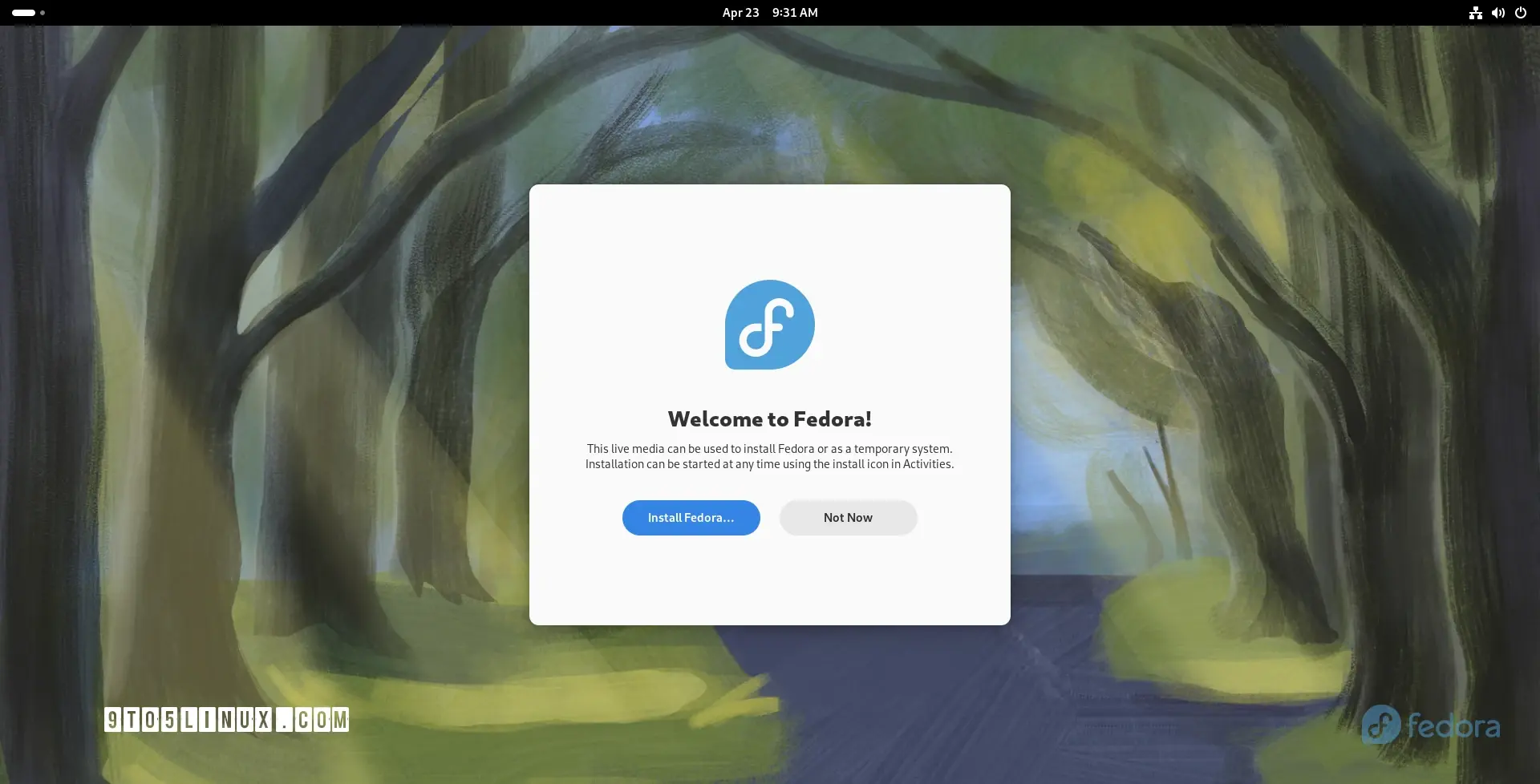






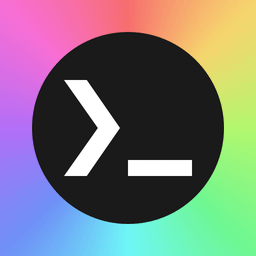


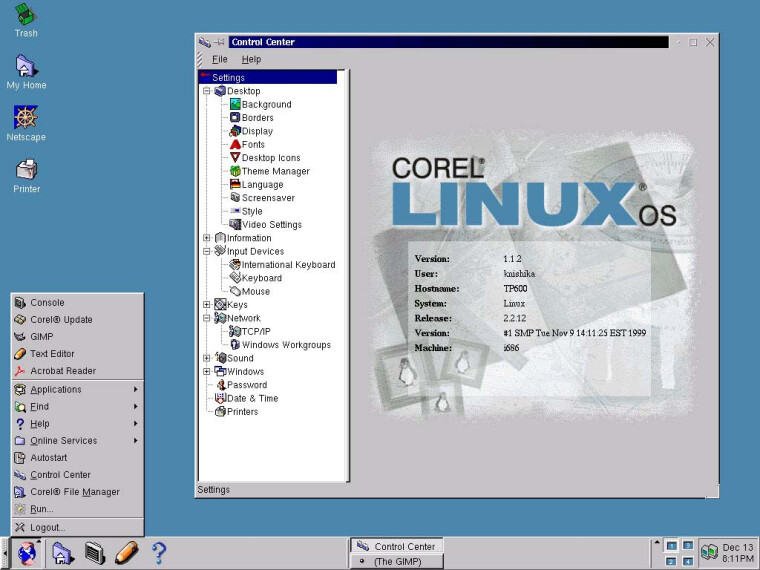
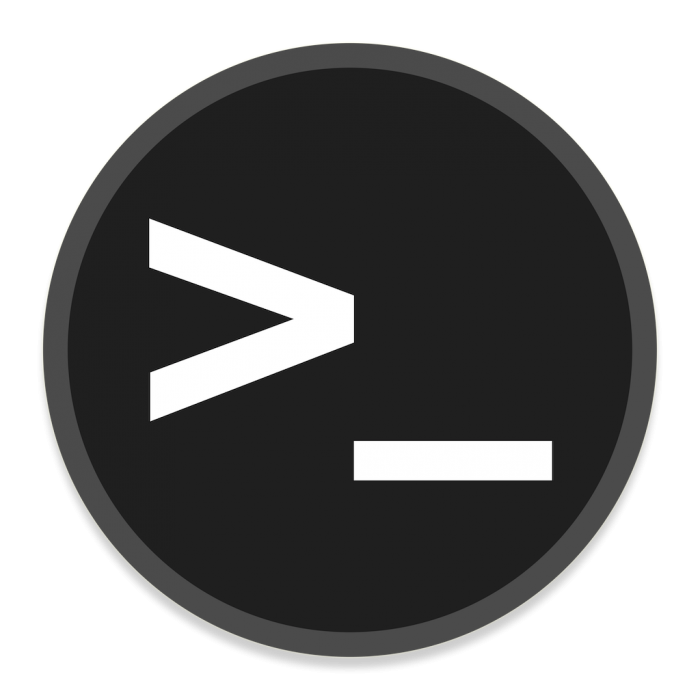





I’ve disabled the “other” option now, someone hijacked the poll. Guess that’s what I get for allowing users to add their own options. >_<